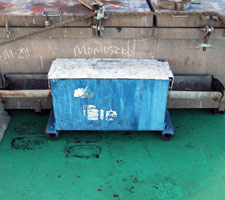Downhole logging tools
Other Equipment
Calibration Equipment
Calibration is a critical step in making sure logging tools provide accurate quantitative results. On the JOIDES Resolution, three forms of calibration are employed: the master calibration, the "before calibration," and the "after calibration."
Master calibration is necessary for nuclear tools, such as those measuring porosity, density, and natural gamma ray emissions. This is accomplished using special test equipment like the SFT-178 (large yellow tank) filled with water for porosity calibration or the GCB-A (blue aluminium block) used for density calibration. Natural gamma ray detectors, on the other hand, require only a small “blanket” containing a material that emits a known amount of gamma rays. Certain tools, such as the DIT, require specialized equipment that is not available on the rig and therefore must be calibrated periodically at a Schlumberger base onshore.
In addition to the intensive master calibration, each tool is given a brief pre-job check known as a "before survey calibration," or "B-Cal" for short. When the logging run has been completed, the tools are again subjected to a brief "after survey calibration," or "A-Cal." The B-Cal and A-Cal are checked against the master cal automatically with specialized software and verified by the logging engineer to ensure that the tools are producing accurate data.
 |
 |
| SFT-178 tank employed for porosity calibration. | Blue aluminum block employed for density calibration. |